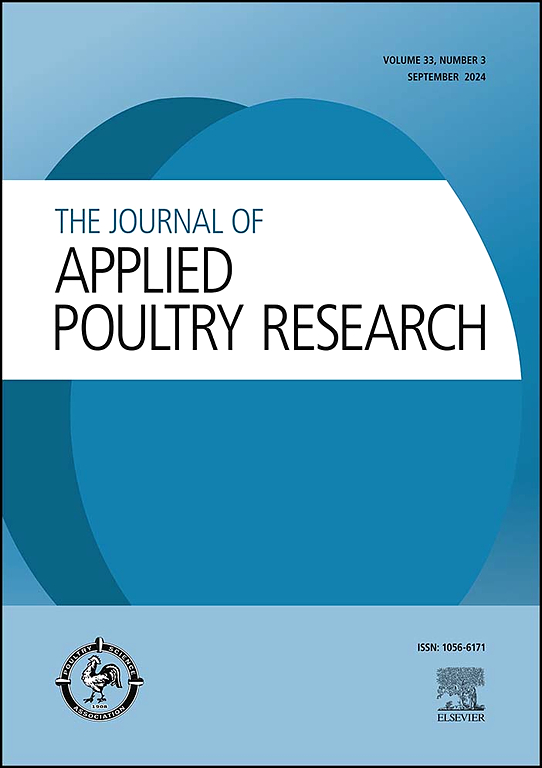Impact of probiotic supplementation in early or late feeding programs on growth performance and mucin gene expression in broiler chickens
IF 1.6
3区 农林科学
Q2 AGRICULTURE, DAIRY & ANIMAL SCIENCE
引用次数: 0
Abstract
This experiment aimed to assess the effects of combining early or late feeding programs with prebiotics on the growth performance, carcass characteristics, blood metabolites, mucin-2 gene expression, and intestinal morphology of broiler chickens. A total of 720 day-old male and female (50:50) broiler chicks were randomly assigned to a 2 × 3 factorial arrangement with 24 experimental units (pens) and 30 birds/pen for 6 wk. Six treatments consisted of 2 feeding programs (early: fed at hatchery; or late: 48 h feed deprivation) and 3 levels of prebiotic supplementation (none, recommended dosage, or 3 times the recommended dosage). Late access to feed during the starter phase resulted in decreased feed intake (FI) and weight gain (WG), as well as increased feed conversion ratio (FCR) (P < 0.05). During the entire rearing period, broilers in the early feeding program, fed diets without prebiotics had higher mortality rates compared to other treatment groups (P < 0.05). Also, the feeding programs and inclusion of prebiotics in the diets did not have a significant effect on FI, WG, or FCR. In both feeding programs, the supplementation of prebiotic resulted in improved ileal morphology indicators and increased mucin-2 gene expression (P < 0.05). The use of prebiotic in both the early and late access to feed groups led to decreased serum levels of triglycerides and uric acid (P < 0.05). In conclusion, late access to feed negatively affected the early growth performance of broiler chicks. Prebiotic supplementation positively influenced mucin-2 gene expression, especially in early feeding programs. Early feed access combined with prebiotics improved intestinal health compared to late access. While prebiotic did not affect overall growth performance, it reduced mortality rates. Further studies are recommended.
在早期或晚期饲喂计划中补充益生菌对肉鸡生长性能和粘蛋白基因表达的影响
本实验旨在评估早期或晚期饲喂益生素对肉鸡生长性能、胴体特征、血液代谢物、粘蛋白-2 基因表达和肠道形态的影响。将 720 只日龄雌雄(50:50)肉用仔鸡随机分配到 24 个实验单元(鸡舍)中,每个单元 30 只,共 6 周。六个处理包括 2 种饲喂方案(早期:在孵化场饲喂;或晚期:48 小时不喂饲料)和 3 种益生元补充水平(无、推荐剂量或推荐剂量的 3 倍)。在开食期较晚摄入饲料会导致采食量(FI)和增重(WG)下降以及饲料转化率(FCR)上升(P <0.05)。在整个饲养期间,与其他处理组相比,早期饲喂方案中饲喂不含益生元的日粮的肉鸡死亡率更高(P <0.05)。此外,饲喂方案和日粮中添加益生素对FI、WG或FCR没有显著影响。在两种饲喂方案中,添加益生素都能改善回肠形态指标并增加粘蛋白-2基因的表达(P < 0.05)。在较早和较晚采食饲料组中使用益生素可降低血清中甘油三酯和尿酸的水平(P < 0.05)。总之,较晚采食饲料对肉用仔鸡的早期生长性能有负面影响。补充益生元对粘蛋白-2基因表达有积极影响,尤其是在早期饲喂计划中。与较晚采食相比,较早采食饲料并添加益生素可改善肠道健康。虽然益生素对总体生长性能没有影响,但却降低了死亡率。建议开展进一步研究。
本文章由计算机程序翻译,如有差异,请以英文原文为准。
求助全文
约1分钟内获得全文
求助全文
来源期刊

Journal of Applied Poultry Research
农林科学-奶制品与动物科学
CiteScore
4.10
自引率
10.50%
发文量
80
审稿时长
104 days
期刊介绍:
The Journal of Applied Poultry Research (JAPR) publishes original research reports, field reports, and reviews on breeding, hatching, health and disease, layer management, meat bird processing and products, meat bird management, microbiology, food safety, nutrition, environment, sanitation, welfare, and economics. As of January 2020, JAPR will become an Open Access journal with no subscription charges, meaning authors who publish here can make their research immediately, permanently, and freely accessible worldwide while retaining copyright to their work. Papers submitted for publication after October 1, 2019 will be published as Open Access papers.
The readers of JAPR are in education, extension, industry, and government, including research, teaching, administration, veterinary medicine, management, production, quality assurance, product development, and technical services. Nutritionists, breeder flock supervisors, production managers, microbiologists, laboratory personnel, food safety and sanitation managers, poultry processing managers, feed manufacturers, and egg producers use JAPR to keep up with current applied poultry research.
 求助内容:
求助内容: 应助结果提醒方式:
应助结果提醒方式:


